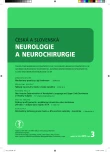Extracranially Metastasizing Meningiomas
Authors:
T. Krejčí 1; S. Potičný 1; T. Hrbáč 1; R. Lipina 1,2; Z. Večeřa 1; J. Dvořáčková 2,3; T. Paleček 1
Authors place of work:
Neurochirurgická klinika FN Ostrava
1; Lékařská fakulta OU v Ostravě
2; Ústav patologie FN Ostrava
3
Published in the journal:
Cesk Slov Neurol N 2013; 76/109(3): 322-328
Category:
Původní práce
Summary
Aim:
The aim of the paper was to retrospectively review patients who underwent surgery for meningioma at the Neurosurgery Clinic of the University Hospital in Ostrava between 2003 and 2005, focusing on evidence of extracranial spread of meningiomas.
Material and methods:
In total, 220 patients with 227 meningiomas underwent surgery. In 196 cases (86.3%), meningiomas were grade I, grade II in 26 cases (11.5%) and grade III in 5 cases (2.2%). Convexity meningiomas dominated with 53 cases (23.3%), followed by falcine and parasagittal in 44 cases (19.4%) and other types. The disease recurred in 29 cases with the shortest follow-up of three years (3–8 years).
Results:
An extracranial metastasis was found in two patients (0.88%). A female patient with parasagittal meningioma developed solitary right lung metastasis nine years after the first surgery. A male patient with intraventricular meningioma developed solitary metastasis of the right lung with mediastinal nodal involvement within 28 months from the first surgery. Later, metastases were found in the liver. In the female patient, metastases were found during section. The male patient died 16 months after the extracranial spread of meningioma was identified. Both patients suffered from atypical meningioma that later upgraded to anaplastic meningioma.
Conclusion:
Meningiomas are rarely able to spread extracranially. However, this possibility must not be overlooked, especially in meningeomas WHO grade II and III, where such spread is relatively frequent. In our opinion, these patients should as part of routine follow-up undergo screening of the most commonly affected organs (lungs, lymph nodes, bones, abdominal organs).
Key words:
metastasis – meningioma – brain tumours
Zdroje
1. Evans JJ, Lee JH, Suh J, Golubic M. Meningiomas. In: Moore AJ, Newell DW (eds). Tumour Neurosurgery, Principle and Practise. London: Springer Verlag 2006 : 205–234.
2. Mawrin C, Perry A. Pathological classification and molecular genetics of meningiomas. J Neurooncol 2010; 99(3): 379–391.
3. Vernooij MW, Ikram MA, Tanghe HL, Vincent AJ, Hofman A, Krestin GP et al. Incidental findings on brain MRI in the general population. N Engl J Med 2007; 357(18): 1821–1828.
4. Enam SA, Abdulrauf S, Mehta B, Malik GM, Mahmood A. Metastasis in meningioma. Acta Neurochir (Wien) 1996; 138(10): 1172–1177.
5. Krejčí T, Hrbáč T, Lipina R, Paleček T. Primárně extradurální meningeom prezentující se Garcinovým syndromem – kazuistika. Cesk Slov Neurol N 2012; 75/108(4): 490–493.
6. Duba M, Mrlian A, Smrčka M, Musil J. Diagnostika, terapie a dispenzarizace meningeomů na NCHK FN Brno v letech 2005–2010. Cesk Slov Neurol N 2013; 76/109(2): 211–216.
7. Lee GC, Choi SW, Kim SH, Kwon HJ. Multiple extracranial metastases of atypical meningiomas. J Korean Neurosurg Soc 2009; 45(2): 107–111.
8. Jančálek R, Novák Z, Chrastina J, Slaná B, Feitová V. Radioterapií indukované meningeomy. Cesk Slov Neurol N 2011; 74/107(2): 191–196.
9. Cerdá-Nicolás M, Lopez-Gines C, Perez-Bacete M, Roldan P, Talamantes F, Barberá J. Histologically benign metastatic meningioma: morphological and cytogenetic study. Case report. J Neurosurg 2003; 98(1): 194–198.
10. Al-Mefty O, Kadri PA, Pravdenkova S, Sawyer JR, Stangeby C, Husain M. Malignant progression in meningioma: documentation of a series and analysis of cytogenetic findings. J Neurosurg 2004; 101(2): 210–218.
11. Gladin CR, Salsano E, Menghi F, Grisoli M, Ghielmetti F, Milanesi I et al. Loss of heterozygosity studies in extracranial metastatic meningiomas. J Neurooncol 2007; 85(1): 81–85.
12. Teague SD, Conces DJ Jr. Metastatic meningioma to the lungs. J Thorac Imaging 2005; 20(1): 58–60.
13. Drummond KJ, Bittar RG, Fearnside MR. Metastatic atypical meningioma: case report and review of the literature. J Clin Neurosci 2000; 7(1): 69–72.
14. Rawat B, Franchetto AA, Elavathil J. Extracranial metastases of meningioma. Neuroradiology 1995; 37(1): 38–41.
15. Liu M, Wei Y, Liu Y, Zhu S, Li X. Intraventricular meninigiomas: a report of 25 cases. Neurosurg Rev 2006; 29(1): 36–40.
16. Brodbelt A, Stoodley M. An anatomical and physiological basis for CSF pathway disorders. In: Mallucci C, Sgouros S (eds). Cerebrospinal Fluid Disorders. New York: Informa 2010 : 1–17.
17. Moubayed SP, Guertin L, Lambert C, Desrochers P, Nehmé J, Coulombe G. Successful treatment of anaplastic meningioma metastatic to cervical lymph nodes. Head Neck. In press. doi: 10.1002/hed. 21938.
18. Sioka C, Kyritsis AP. Chemotherapy, hormonal therapy, and immunotherapy for recurrent meningiomas. J Neurooncol 2009; 92(1): 1–6.
19. Chamberlain MC, Glantz MJ, Fadul CE. Recurrent meningioma: salvage therapy with long-acting somatostatin analogue. Neurology 2007; 69(10): 969–973.
20. Ragel BT, Couldwell WT, Wurster RD, Jensen RL. Chronic suppressive therapy with calcium channel antagonists for refractory meningiomas. Neurosurg Focus 2007; 23(4): E10.
Štítky
Detská neurológia Neurochirurgia NeurológiaČlánok vyšiel v časopise
Česká a slovenská neurologie a neurochirurgie

2013 Číslo 3
- Metamizol jako analgetikum první volby: kdy, pro koho, jak a proč?
- Fixní kombinace paracetamol/kodein nabízí synergické analgetické účinky
- Neuromultivit v terapii neuropatií, neuritid a neuralgií u dospělých pacientů
- Srovnání analgetické účinnosti metamizolu s ibuprofenem po extrakci třetí stoličky
- Kombinace metamizol/paracetamol v léčbě pooperační bolesti u zákroků v rámci jednodenní chirurgie
Najčítanejšie v tomto čísle
- Mechanizmy spasticity a její hodnocení
- Lidské prionové nemoci v České republice – 10 let zkušeností s diagnostikou
- Myozitida s inkluzními tělísky se slabostí šíjových svalů a pozitivním efektem imunoglobulinu – kazuistika
- Extrakraniálně metastazující meningeomy
